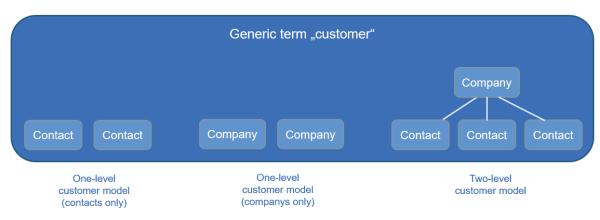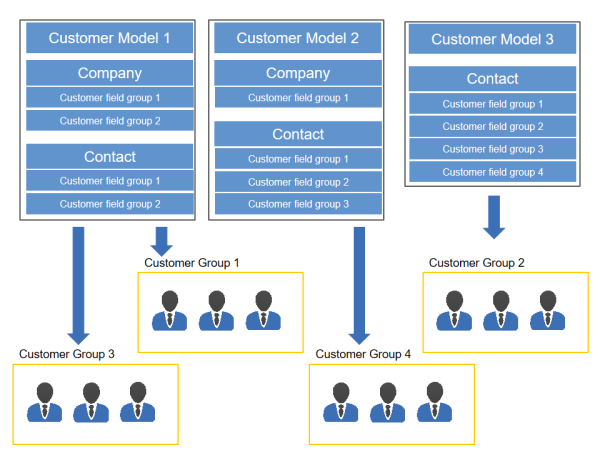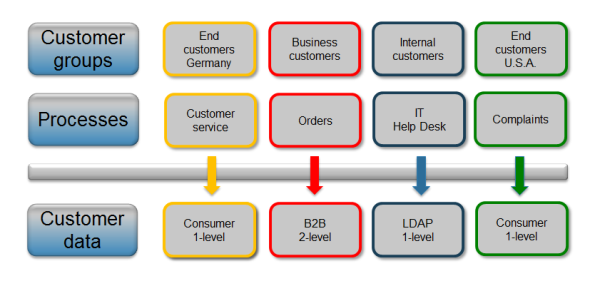Introduction to Customer Data Models
The Flexible Customer Data Model at a Glance
The ConSol CM customer data model, also called FlexCDM, offers a very high degree of flexibility. Various customer groups can be defined, each with its particular data model.
In ConSol CM, we talk about customers to describe the general CM object. This can be either a company or a contact. A company represents an object on company level which will, in most cases, be a real company, a subsidiary, a division or some other organizational unit on a higher level. It can also be a collection of products, a machine pool, or any other object which comprises sub-objects. A contact represents an object on contact level, i.e., on the lower level of the customer model. A contact will often be a real person but can also be a product, a machine or some other object.
Contacts as well as companies can be set as customer for a ticket.
There are different ways to configure customer data models for customer groups. Within a customer group, there might be ...
- a contact and a company level:
then we talk about a two-level customer data model (where a company can contain several contacts) - only a contact or only a company level:
then we talk about a one-level customer data model
Figure 85: Types of customer data models in ConSol CM
For example, you could classify your customers in two customer groups:
- Resellers
With contact and company level. - End customers
With contact level only.
You can configure as many customer data models as required. Every customer data model can be used for one or more customer groups.
A customer data model comprises the general model, i.e. the levels (contact and company or contact/company only) and all data fields for all components (e.g. name, address, and phone for a company or name, email, and room number for a contact).
Figure 86: ConSol CM customer data models - General principle
For a two-level customer data model:
The terms company and contact are used to indicate the hierarchical level of an object within the customer data model. An object of type company does not necessarily have to be a real company, it can also be a town with several machines (contacts) located in this town, an organization with several subsidiaries (contacts), or even a technical unit (e.g. a ship) with several contacts in the unit. Similarly, an object of type contact does not necessarily have to be a person, it can also be a location, a machine, or anything else which should represent the contact level.
For a one-level customer data model:
The customer objects in a one-level customer model are either of type contact or of type company.
For the customers which are managed by your ConSol CM system, the levels and names of all components entirely depend on the configuration of the customer data model.
The possibility to create different customer data models within your ConSol CM system allows you to build different realms where each includes a specific customer group and the respective data and processes.
Figure 87: ConSol CM - Customer data model
Please see section Setting Up the Customer Data Model for a detailed description of the customer management.
Introduction to the Objects in the Customer Data Model
In this section, we will give you an overview of all objects which are relevant for the customer data model.
Figure 88: ConSol CM - Example configuration with three customer data models
Important Terms Used for Objects in the Customer Data Model
The above description uses the Admin Tool terms for the objects in the customer data model. The terms used in the Web Client, i.e., displayed to the end users, can be configured using Labels.
The following table contains an overview of the definitions, the terms used in the Admin Tool, and the default values for the Web Client after an update to the latest ConSol CM version.
|
Definition |
Admin Tool term |
Default Web Client term |
|---|---|---|
|
general term for customer objects, can be of type contact or of type company |
customer |
contact |
|
customer object of type company, company level |
company |
company |
|
customer object of type contact, contact level |
contact |
person |
|
group of customers with a specific customer data model, basis for the assignment of permissions |
customer group |
customer group |
|
object within the customer data model, can be a contact or a company |
customer object (technically called a unit) |
(not used) |
|
all definitions pertaining to the customer object, i.e., customer field groups, assigned annotations, assigned templates |
customer object definition |
(not used) |
|
a group comprising one or more data fields (customer fields) |
customer field group |
contact field group |
|
a single data field that can contain customer data |
customer field |
contact field |
|
whole data model that can be assigned to a customer group, can have:
|
customer data model |
customer data model |
|
relations between a company and contacts or between companies or between contacts |
customer relations |
contact relations |
|
application of the Action Framework used for customers |
customer actions |
contact actions |
Please note that the default terms for the Web Client depend on the type of setup. For new installations of ConSol CM, the Web Client terms from the above table are used. For update installations from a previous version of ConSol CM, the default values match the Admin Tool terms from the above table.



